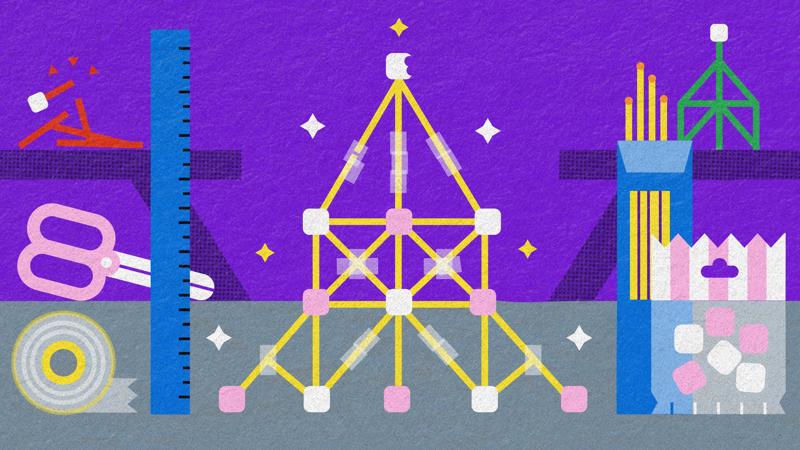
Play Equity Spaghetti
You’ll need
- Tables
- Chairs
- Scissors
- Spaghetti (10 pieces per team)
- Marshmallows (2 per team)
- Sticky tape (5 pieces per team)
Before you begin
- Use the safety checklist to help you plan and risk assess your activity. Additional help to carry out your risk assessment, including examples can be found here. Don’t forget to make sure all young people and adults involved in the activity know how to take part safely.
- Make sure you’ll have enough adult helpers. You may need some parents and carers to help if you’re short on helpers.
Planning this activity
- This activity uses marshmallows and spaghetti. Remember to check for allergies, eating problems or dietary requirements and adjust the recipe as needed. Make sure you've checked everyone's dietary requirements and allergies then adapted the recipe as appropriate. This may include ensuring no cross-contamination during food storage, preparation and serving, too. Check if there are any items of food (or packaging) that people can’t touch or be near to or if there are items that people might not be comfortable using in the activity.
- Prepare green, yellow and red cards with instructions for the teams in advance.
- Assign someone as the ‘facilitator’ for this activity, it could be an adult leader, a young leader or a member of the group.
Run this activity
- Split everyone into at least three groups and assign each one either green, red and yellow. Make sure each team has a table to work on and hand out the spaghetti, marshmallows, tape and scissors. Each team needs 10 pieces of spaghetti, 2 marshmallows, 5 pieces of sticky tape and a pair of scissors.
- Give the teams these instructions: You have 15 minutes to build the highest spaghetti tower you can. It must be placed on the table, be able to stand by itself, and support a marshmallow on top.
- When it’s time to start, hand out the cards to each team.
- The ‘facilitator’ should find a space to stand and if team members want to speak to them, they should queue up.
- The facilitator can decide whether to fast track members of the green team to the front. The facilitator will have a fixed amount of extra resources they’ll give to the green team when they ask. They’ll have the same amount to hand out to the yellow team, but will only hand out what they feel like, based on the request, their reasons, and the way they ask. If the red team ask for any extra resources, they should be told that they can’t take anything. It’s not expressly said, but there is no rule that requires teams to build separate towers, and no rules to stop anyone sharing resources.
- Once the 15 minutes is up, as a group everyone should review the towers and see which team managed to build the tallest.
- To finish, spend some time reflecting on the challenge.
As greens, you are entitled to additional resources for this challenge. Take this card to the facilitator who’ll provide these for you.
As yellows, you may be eligible for extra resources for this challenge. Take this card to the facilitator, along with an explanation of what you need and why you need it. The facilitator will decide whether you can have it, their decision is final.
As reds, we wish you the best of luck in this challenge. Good luck!
Reflection
At first glance this activity was all about working as a team and solving problems, but it also helped everyone to explore some issues related to unequal distribution of resources and opportunity.
Ask everyone to think about how they found the activity, and how it felt to be in the team they were in. Do they think they did a good job building the tower? Would they want to change teams?
Ask each team to share what was written on their card. Did anyone realise that they had different instructions?
Spend some reflecting and ask everyone to chat about how it feels to be on the receiving end of differential treatment. Differential treatment is where people are treated unfairly (or unequally) because of specific characteristics they’re unable to change. For example, in this activity the factor that people couldn't change was the team they were put into.
To finish, ask the teams if they think they could have done anything differently. Did anyone think about sharing resources and banding together to build one giant tower?
Safety
All activities must be safely managed. You must complete a thorough risk assessment and take appropriate steps to reduce risk. Use the safety checklist to help you plan and risk assess your activity. Always get approval for the activity, and have suitable supervision and an InTouch process.
- Scissors
Supervise young people appropriately when they’re using scissors. Store all sharp objects securely, out of the reach of young people.
- Food
Remember to check for allergies, eating problems, fasting or dietary requirements and adjust the recipe as needed. Make sure you’ve suitable areas for storing and preparing food and avoid cross contamination of different foods. Take a look at our guidance on food safety and hygiene.
Think about changing the amount of resources you give each team to start, you could provide more or less to make this more challenging. You could change things like the amount of time to build, the number of people in each team or ask them to build a more complicated structure.
If anyone struggles with fine motor skills, you could suggest working in pairs. Alternatively, swap out the spaghetti for something easier to handle – it could be breadsticks, some pens or pencils or some small sticks or lengths of bamboo.
All Scout activities should be inclusive and accessible.


